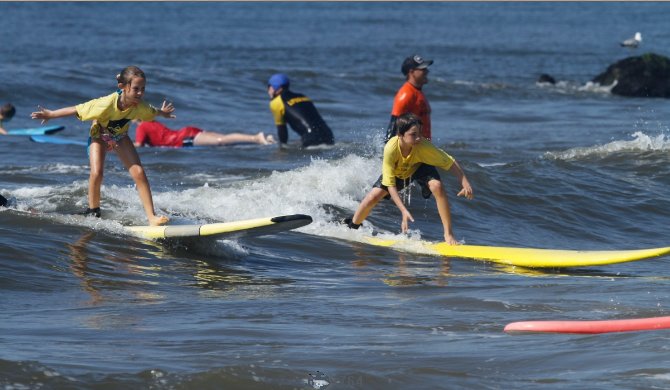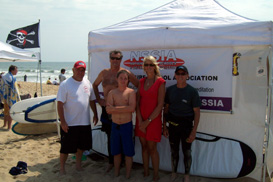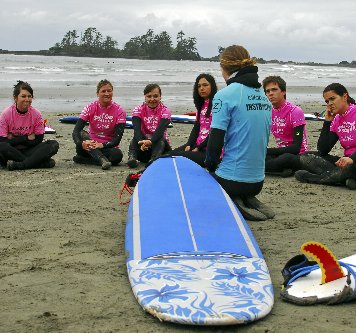 |
National Surf Schools & Instructors Association (NSSIA) | ||||||||||||
| The
Official Professional Association for the Surf School Industry Protecting Both Industry and Students • Established 2005 AN IRS REGISTERED NON-PROFIT ORGANIZATION |
|||||||||||||
|
|||||||||||||
|
|||||||||||||
| NSSIA
Code of Ethics for Surf/SUP Schools and Ocean SUP/Surfers |
|
SURF/SUP SCHOOLS - THE RULES OF THE ROAD |
| Organizations and surf/SUP schools accredited by the NSSIA subscribe to the following Surf/SUP School Code of Ethics. |
The keyword for the
conduct of surf/SUP schools is "Low Impact".
|
| Surf Schools operate in the surf, which we share with the surfers in the water, so we must always be respectful of the surfers in the water, and remain low-impact on them. |
| This means going down the beach away from any congregations of surfers. This is both safer for the surf/SUP school student, and it leaves the good waves for the surfers in the water. |
| Beginners need whitewater, and traditionally go down the beach from surf breaks with more experienced surfers. |
The Surf School Student
needs to be instructed to stay out of congregations of surfers in
the water and any kind of crowded surfing conditions. This is a
safety issue, not a "localism" issue.
|
| Below is what a surf/SUP school student needs to be able to accomplish in the surf in order to surf/SUP among other surfers and not be a danger to himself or other surfers: |
| Until the surf school student can move his surfboard around quickly and with agility to where he wants it to go, then he needs to stay out of any crowded conditions, out of any congregations of surfers in the water at any given surf break. |
| When riding a wave, the surf/SUP school student also needs to know how to turn well enough to avoid running over a surfer paddling out in his path. |
| After the student is able to paddle well enough and turn, then he is ready to handle more surfers around him in the break. Always be sure to stress these two points to surf students, and further, emphasize that staying out of crowded surfing conditions is a safety issue, and not a "localism" issue. |
| NSSIA Surf/SUP School Code of Ethics in Summary |
| Stay
out of existing surf spots where people are surfing As a surf/SUP school on a public beach, it is important not to take the beginners into surf spots where people are already surfing. The beginners, traditionally, go down the beach away from the peaks with the expert riders. |
| STUDENT
TRAINING: Paddling Ability of the Beginner Be sure to emphasize to the beginning surf student that until they can paddle their surfboard quickly and with agility through the waves, and have some control over where their board is going, it is important that he stay out of any crowded situation. |
| STUDENT
TRAINING: Turning Ability of the Beginner Until a beginner is good enough and has enough control over his board to be able to turn and not run over a surfer in his path, it is also best to stay out of the crowds. |
| SURFING AND SURFERS - THE RULES OF THE ROAD |
| NSSIA Surfing Code of Ethics |
| Instructors certified by the NSSIA subscribe to the following Surfing/SUP Code of Ethics. |
| There are some basic, common sense "regulations" of surfing to help everyone have a better time while surfing and avoid confrontations. |
|
|
|
The surfing regulations recommended by the NSSIA are as follows: |
| DON'T
TAKE OFF IN FRONT OF SOMEONE ELSE - 'THE PRIORITY RULE' The surfer who takes off nearest the peak and catches the wave first has the right of way. Once someone is up and riding, do not attempt to catch the wave if it will place you in their path. This is the number one rule in surfing, and breaking this rule is the biggest cause of altercations among surfers in the water. |
| WHEN
PADDLING OUT, STAY OUT OF THE WAY OF RIDING SURFERS If you are paddling out, and another surfer is riding, it is your responsibility to get out of the way and not ruin the surfer's wave. For example, If the surfer is riding toward the left on the wave, it is best to paddle right, parallel to the oncoming wave and out of the rider's way, instead of trying to paddle over the green, open face of the wave and potentially in the path of the rider. |
| DEALING
WITH “LOCALS” If you paddle out at a spot you don't normally surf, half-a-dozen or so guys will look at you like, "What do you want?" Okay, those are the "locals" and every wave is their wave. Sit out on the shoulder, and give them any wave they want. There are also going to be a couple waves that they miss, and those waves are yours. You might not get as many waves as you want if surfing a localized spot that you're not familiar with, but you will get some waves. What the locals are afraid of is the surfer who paddles out, paddles into the heart of the pit, then takes off deep and shouts "locals" off the shoulder. Basically, a surfer who paddles out and takes over. Once you show them that you are not going to aggressively pursue "their" waves, you will work your way into the lineup and get your fair share of waves. |
| DON'T
TAKE EVERY WAVE IN CROWDED CONDITIONS: DON'T BE A "WAVE HOG" Don't try to catch every single wave that comes through. Someone who does this is what's is known as a "wave hog." Wave hogs will create great animosity among the other surfers in the water. Trade off with the others, especially if the waves are inconsistent. Consistent waves allow for everyone getting waves. THIS RULE IS PARTICULARLY IMPORTANT FOR SUP SURFERS WHO CAN SIT OUTSIDE AND TAKE OFF ON WAVES EARLIER THAN TRADITIONAL SURFERS. |
| If you are riding a longboard among shortboard surfers, be sure not to take more than your share of the waves, because with a longer board it is possible to catch the waves further out before the shortboard surfer even has a chance to catch it. |
| KEEP
CONTROL OF YOUR EQUIPMENT Never ever attempt a move, maneuver, turn or aerial that will cause you to collide with another surfer. Always get a good look at surfers paddling out as you are taking off so that you are able to avoid running them over. |
| DON'T
MANUEVER AROUND ANOTHER SURFER ABOUT TO TAKE OFF TO CLAIM THE INSIDE
POSITION: DON'T "SNAKE'' WAVES When a first surfer is about to take off a wave, then a second surfer, who is nowhere near the point of take-off, paddles over and around the first surfer to take the inside position and takes off, the second surfer has just snaked the first surfer, and has just stolen the wave from the first surfer. This maneuver causes animosity, and should be avoided. |
| Beginner Surfer's Tips |
| AVOID CROWDED CONDITIONS |
| Until you can paddle your surfboard quickly and with agility to where you want it to go, it's a matter of the safety and yourself to stay out of any crowded surfing conditions. |
| If you are not able to turn while surfing to avoid running over a surfer in your path, it's also unsafe for you to be surfing in crowded surfing conditions. |
| As a beginner, when you are still gaining the wave judgment and paddling skills necessary to paddle the board quickly and with agility to get it where you want it to go, surfing in crowded areas can be a real safety hazard for yourself and others. When riding, you also need to have enough skill to turn and miss somebody paddling out in your path, so that you don't run them over. So until you can paddle well and know how to turn, as a safety precaution it's good practice to head down the beach and find your own surf spot away from the others. |
| SURFING
LARGE WAVES If the waves are so big that you wouldn’t feel confident swimming in them, don’t take a surfboard out in the waves. Don’t depend on a leash as a lifesaving device. |
| LEASHES
ARE NOT LIFE-SAVING DEVICES Leashes are not designed as lifesaving devices. The original intent of the leash was for surfing rocky areas. If you lost your board in these surf spots, you’re board had a good chance of getting severely damaged in the rocks. An individual trying to retrieve his board, had a good chance of getting injured while retrieving it. |
| IMPROVING
YOUR SURFING/SUP: PRACTICE Surfing, like any sport, takes a great deal of practice to achieve any level of expertise. If you want to improve then you need to be in the water surfing as regularly and as much as possible. Getting better at surfing is all about water-time. The more time you spend in the water, the better you will get. You can read whatever you want in any “How To Surf’ guide, but it’s not going to do you any good unless you get out in the water. A lot of surfing is about feel, and does not translate well into any language. |
site map | contact | www.nssia.org
The National Surf Schools and Instructors Association (NSSIA) official website © 2005-2008 • All rights reserved
AN IRS REGISTERED NON-PROFIT ORGANIZATION


